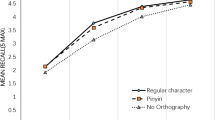Abstract
Subtitled television programs seem to provide a rich context for foreign language acquisition. Moreover, viewers are generally quite motivated to understand what is shown and said on television. The present study investigated whether children in Grades 4 and 6 (N = 246) learn English words through watching a television program with an English soundtrack and Dutch subtitles. Children were randomly assigned to one of three experimental conditions: (a) watching an English television program with Dutch subtitles, (b) watching the same English program without subtitles, and (c) watching a Dutch television program (control). The study was carried out using a 15-min documentary about grizzly bears. Vocabulary acquisition and recognition of English words were highest in the subtitled condition, indicating that Dutch elementary school children can incidentally acquire vocabulary in a foreign language through watching subtitled television programs.
Similar content being viewed by others
References
Anderson, R.C., & Nagy, W.E. (1991). Word meanings. In R. Barr, M.L. Kamil, P. Mosenthal, & P.D. Pearson (Eds.),Handbook of reading research (Vol. 2, pp. 690–724). New York: Longman.
Beck, I., & McKeown, M. (1991). Conditions of vocabulary acquisition. In In R. Barr, M.L. Kamil, P. Mosenthal, & P.D. Pearson (Eds.),Handbook of reading research (Vol. 2, pp. 789–814). New York: Longman.
Borrás, I., & Lafayette, R.C. (1994). Effects of multimedia courseware subtitling on the speaking performance of college students of French.The Modern Language Journal, 78, 61–75.
Dunn, L., & Dunn, L. (1981).Peabody Picture Vocabulary Test—revised. Circle Pines, MN: American Guidance Service.
d'Ydewalle, G., & Pavakanun, U. (1995). Acquisition of a second/foreign language by viewing a television program. In P. Winterhoff-Spurk (Ed.),Psychology of media in Europe: The state of the art—perspectives for the future (pp. 51–64). Opladen, Germany: Westdeutscher Verlag.
d'Ydewalle, G. & Pavakanun, U. (1997). Could enjoying a movie lead to language acquisition. In P. Winterhoff-Spurk and T.H.A. van der Voort (Eds.),New horizons in media psychology: Research cooperation and projects in Europe (pp. 145–155). Opladen, Germany: Westdeutscher Verlag.
d'Ydewalle, G., Praet, C., Verfaillie, K., & van Rensbergen, J. (1991). Watching subtitled television: Automatic reading behavior.Communication Research, 18, 650–666.
Edelenbos, P. (1990).Leergangen voor Engels in het basisonderwijs vergeleken [A comparison of English curricula for elementary schools]. Groningen, the Netherlands: RION.
Fröhlich, J. (1996). Medien im Deutsch-alsfremdsprache-unterricht: “Die Deutsche Welle”. [Media in the German-as-a-foreign-language classroom: Deutsche Welle].Unterrichtspraxis, 29, 92–95.
Grant, L.E. (1996). Teaching conversation using a television soap.Prospect, 11, 60–71.
Jenkins, J.R., Stein, M., & Wysocki, K. (1984). Learning vocabulary through reading.American Educational Research Journal, 21, 767–787.
Kilborn, R. (1993). ‘Speak my language’: Current attitudes to television subtitling and dubbing.Media, Culture, and Society, 15, 641–660.
Kirk, R.E. (1968).Experimental design: Procedures for the behavioral sciences. Belmont, CA: Brooks/Cole Publishing Company.
Koolstra, C.M., van der Voort, T.H.A., & van der Kamp, L.J.Th. (1997). Television's impact on children's reading comprehension and decoding skills: A 3-year panel study.Reading Research Quarterly, 32, 128–152.
Krashen, S. (1985).The input hypothesis: Issues and implications. New York: Longman.
Luyken, G., Herbst, T., Langham-Brown, J., Reid, H., & Spinhof, H. (1991).Overcoming language barriers in television: Dubbing and subtitling for the European audience. Manchester, England: European Institute for the Media.
Mason, K. (1997). Pop culture media icons: Stimuli for language activities.Mosaic, 4(2), 19–22.
Nagy, W.E., Herman, P.A., & Anderson, R.C. (1985). Learning words from context.Reading Research Quarterly, 20, 233–253.
Neuman, S.B., & Koskinen, P. (1992). Captioned television as comprehensible input: Effects of incidental word learning from context for language minority students.Reading Research Quarterly, 27, 95–106.
Oetting, J.B., Rice, M.L., & Swank, L.K. (1995). Quick incidental learning (QUIL) of words by school-age children with and without SLI.Journal of Speech and Hearing Research, 38, 434–445.
Pavakanun, U., & d'Ydewalle, G. (1992). Watching foreign television programs and language learning. In F.L. Engel, D.G. Bouwhuis, T. Bösser & G. d'Ydewalle (Eds.),Cognitive modelling and interactive environments in language learning (pp. 193–198). Berlin: Springer Verlag.
Rice, M.L., & Woodsmall, L. (1988). Lessons from television: Children's word learning when viewing.Child Development, 59, 420–429.
Shu, H., Anderson, R.C., & Zhang, H. (1995). Incidental learning of word meanings while reading: A Chinese and American cross-cultural study.Reading Research Quarterly, 30, 76–95.
Van Lil, J. (1988).Beeld van een kind [Image of a child]. Hilversum, The Netherlands: NOS (Report nr R88-421).
Vann, S. (1996).Using CNN Newsroom in advanced listening classes. Paper presented at the Annual Meeting of the Teachers of English to Speakers of Other Languages (30th, Chicago, IL, March 26–30, 1996).
Vinjé, M. (1994). Kinderen praten Engels: Balans van het Engels aan het einde van de basisschool [Children speak English: Results of English lessons at the conclusion of the elementary school].JSW, 79(4), 32–35.
Author information
Authors and Affiliations
Rights and permissions
About this article
Cite this article
Koolstra, C.M., Beentjes, J.W.J. Children's vocabulary acquisition in a foreign language through watching subtitled television programs at home. ETR&D 47, 51–60 (1999). https://doi.org/10.1007/BF02299476
Issue Date:
DOI: https://doi.org/10.1007/BF02299476




